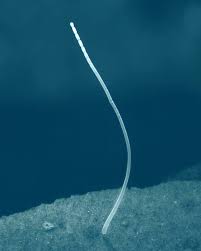Thiomargarita magnifica: Difference between revisions
No edit summary |
|||
| (27 intermediate revisions by the same user not shown) | |||
| Line 1: | Line 1: | ||
{{Uncurated}} | {{Uncurated}} | ||
[[Image: | [[Image:THIOMARGARITA MAGNIFICA.jpeg|thumb|300px|right|Close up view of a filament of ''Thiomargarita Magnifica''. Image credit: Jean-Marie Volland/SciNews.com.]] | ||
==Classification== | ==Classification== | ||
| Line 9: | Line 7: | ||
Bacteria (Domain);Proteobacteria (Phylum);Gammaproteobacteria (Class); Thiotrichales (Order); Thiotrichaceae (Family); Thiomargarita (Genus) | Bacteria (Domain);Proteobacteria (Phylum);Gammaproteobacteria (Class); Thiotrichales (Order); Thiotrichaceae (Family); Thiomargarita (Genus) (1) | ||
| Line 15: | Line 13: | ||
===Species=== | ===Species=== | ||
''Thiomargarita Magnifica'' (1) | |||
''Thiomargarita Magnifica'' | |||
==Description and Significance== | ==Description and Significance== | ||
''Thiomargarita magnifica'' is characterized by large Thiromargarita cells and is gram-negative (4). It is found in tropical marine coastal environments and was specifically discovered in the mangroves of Guadeloupe in the Caribbean (3). It is found to be 1cm in length and can be seen with the naked eye. ''Thiomargarita magnifica'' is important for antibiotic production, evolution, the tree of life, and the sulfur cycle (2). | |||
==Genome Structure== | ==Genome Structure== | ||
DNA in ''Thiomargarita magnifica'' is concentrated in membrane-bound compartments which collectively hold up to 700,000 copies of the genome. These membrane-bound organelles that contain the DNA are called “Pepin.” ''Thiomargarita magnifica'' has a genome as large as baker’s yeast, as it contains three times the median gene count for prokaryotes. Additionally, it contains a large set of genes for sulfur oxidation and carbon fixation (3). | |||
==Cell Structure, Metabolism and Life Cycle== | ==Cell Structure, Metabolism and Life Cycle== | ||
''Thiomargarita magnifica'' does chemosynthesis, which means this microbe gets its energy from converting organic compounds into organic matter as a source of energy. This microbe has a dimorphic life cycle, meaning that it creates asymmetric segregation of chromosomes into daughter cells (3). | |||
==Ecology and Pathogenesis== | ==Ecology and Pathogenesis== | ||
''Thiomargarita magnifica'' is found in tropical marine coastal environments. They grow on sediments at the bottom bodies of water containing sulfur, where they use both sulfur and oxygen to make sugars. Due to their size compared to other microbes in their environment, the bacteria do not have many predators. It has not been found to cause disease, although, it could cause disease within the immunocompromised (3). | |||
==References== | |||
1. JGI IMG. 2022. Cand. Thiomargarita magnifica 72 v.2. IMG. https://img.jgi.doe.gov/cgibin/m/main.cgi?section=TaxonDetail&page=taxonDetail&taxon_oid=2956002012 | |||
== | |||
2. JGI Gold. 2022. Study Information. JGI. https://gold.jgi.doe.gov/study?id=Gs0149408 | |||
3. Volland JM, Gonzalez-Rizzo S, Gros O, et al. A centimeter-long bacterium with DNA contained in metabolically active, membrane-bound organelles. Science. 2022;376(6600):1453-1458. doi:10.1126/science.abb3634 | |||
4. Levin, PA. 2022. A bacterium that is not a microbe. Science. 376(6600):1379-1380. doi:10.1126/science.adc9387 | |||
==Author== | ==Author== | ||
Latest revision as of 20:12, 7 December 2022
Classification
Bacteria (Domain);Proteobacteria (Phylum);Gammaproteobacteria (Class); Thiotrichales (Order); Thiotrichaceae (Family); Thiomargarita (Genus) (1)
Species
Thiomargarita Magnifica (1)
Description and Significance
Thiomargarita magnifica is characterized by large Thiromargarita cells and is gram-negative (4). It is found in tropical marine coastal environments and was specifically discovered in the mangroves of Guadeloupe in the Caribbean (3). It is found to be 1cm in length and can be seen with the naked eye. Thiomargarita magnifica is important for antibiotic production, evolution, the tree of life, and the sulfur cycle (2).
Genome Structure
DNA in Thiomargarita magnifica is concentrated in membrane-bound compartments which collectively hold up to 700,000 copies of the genome. These membrane-bound organelles that contain the DNA are called “Pepin.” Thiomargarita magnifica has a genome as large as baker’s yeast, as it contains three times the median gene count for prokaryotes. Additionally, it contains a large set of genes for sulfur oxidation and carbon fixation (3).
Cell Structure, Metabolism and Life Cycle
Thiomargarita magnifica does chemosynthesis, which means this microbe gets its energy from converting organic compounds into organic matter as a source of energy. This microbe has a dimorphic life cycle, meaning that it creates asymmetric segregation of chromosomes into daughter cells (3).
Ecology and Pathogenesis
Thiomargarita magnifica is found in tropical marine coastal environments. They grow on sediments at the bottom bodies of water containing sulfur, where they use both sulfur and oxygen to make sugars. Due to their size compared to other microbes in their environment, the bacteria do not have many predators. It has not been found to cause disease, although, it could cause disease within the immunocompromised (3).
References
1. JGI IMG. 2022. Cand. Thiomargarita magnifica 72 v.2. IMG. https://img.jgi.doe.gov/cgibin/m/main.cgi?section=TaxonDetail&page=taxonDetail&taxon_oid=2956002012
2. JGI Gold. 2022. Study Information. JGI. https://gold.jgi.doe.gov/study?id=Gs0149408
3. Volland JM, Gonzalez-Rizzo S, Gros O, et al. A centimeter-long bacterium with DNA contained in metabolically active, membrane-bound organelles. Science. 2022;376(6600):1453-1458. doi:10.1126/science.abb3634 4. Levin, PA. 2022. A bacterium that is not a microbe. Science. 376(6600):1379-1380. doi:10.1126/science.adc9387
Author
Page authored by Grace Handle, student of Prof. Bradley Tolar at UNC Wilmington.

